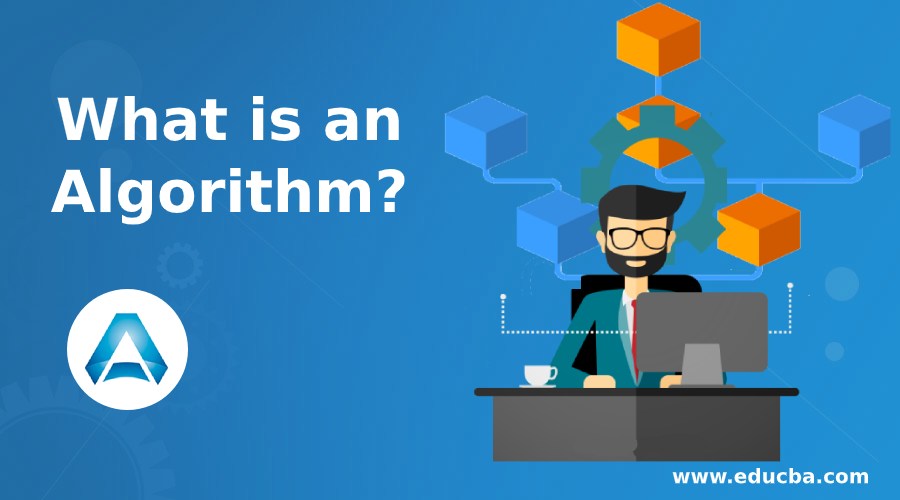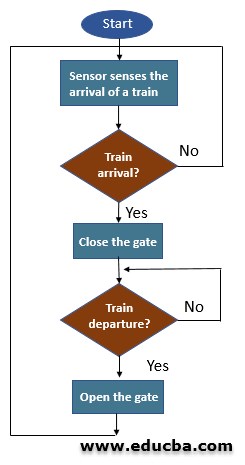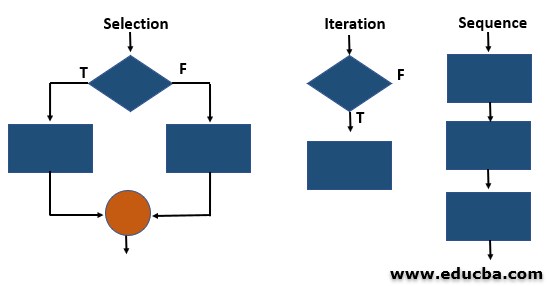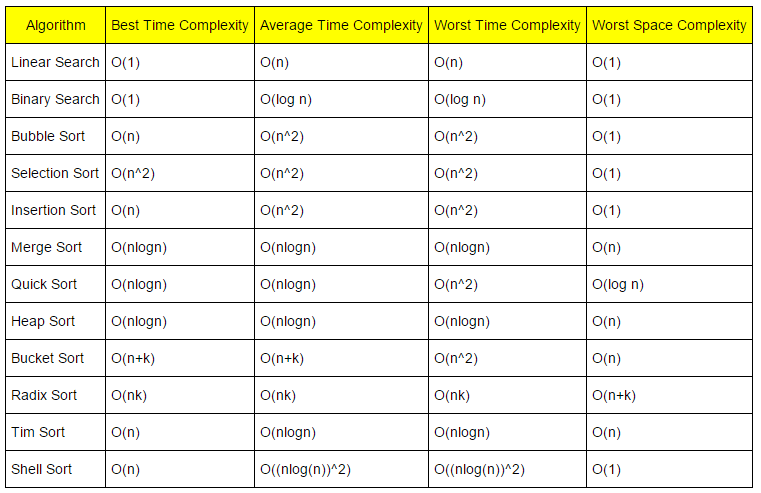Updated May 17, 2023
What is an Algorithm?
The algorithm is a set or arrangement of instructions a human or computer implements to do a process. These instructions help solve a complex problem or help to perform data computation. Computers should follow these instructions to calculate or perform problem-solving operations. They are needed for simple processes such as the multiplication of two numbers or complex problems searching for a compressed file’s contents. Programmers tend to develop suitable algorithms so that the problems are solved better.
For instance, take an example of a railway gate point.
An algorithm should:
- Be Well-defined and well-ordered – The instructions provided in an algorithm should be understandable and defined well.
- Have unambiguous operations, i.e., each of an algorithm’s steps should be simple enough that it may not require any further simplification.
- Have an effectively computable operation.
Understanding Algorithm
Now, let us see it in a flow chart:
A sensor senses the arrival of a train, as an output of which could be 2 results.
- Train is arriving
- The train is not arriving
An action that advises closing the gates receives the result of the first outcome, while the result of the second outcome is tested again by sending it to the initial statement. Furthermore, the output of action, which was the result of the first condition, is tested to check if the train has completely departed. If the answer is yes, gates are opened; if it is negative, they remain closed. We will be discussing this and working with the following topics (The Subsets/Building Blocks and working of an Algorithm).
How Does it Make Work Easy?
As we know, this is a plan for solving a problem. If we do not have a plan, our approach to solving a complex problem will fail in the first attempt, and even if it solves the problem, chances are very less that it will be an optimal solution to that problem.
While on the other hand, if we create an algorithm before solving any problem, let’s say we create a few algorithms and sort them out based on the optimal solution they provide, it would guarantee to solve the given problem. This is the reason why everywhere, before solving any problem, firstly, an algorithm is created.
Top Algorithm Development Companies
Building a great product requires a perfect design. However, we cannot compare an algorithm for two different problems; what we can do is list out the names of companies that have delivered some excellent products to this world throughout the 21st century:
- DeepMind
- Baidu
- Nvidia
- CloudWalk
- SenseTime
- Darktrace
- Cambrian
- IBM
- OpenAI
- ByteDance
- CrowdStrike
- Zebra Medical Vision
- Babylon
- Intel
- Flatiron Health
- Affirm
- Upstart
- Element AI
- CloudMinds
- DataRobot
- Anki
- Zymergen
- UBTECH
Subsets/Building Blocks and Working of an Algorithm
All these years, it has been proven that it can be designed from just three building blocks:
- Sequence
- Selection
- Iteration
A sequence is a series of instructions to solve a problem, and the instructions should be executed in order.
Examples
Here few examples are given below:
1. Addition of two numbers
Step 1: Start
Step 2: Get two numbers as input and store them in a variable as a and b
Step 3: Add the number a & b and store them in variable c
Step 4: Print c
Step 5: Stop
A selection is a program that allows us to choose the output from different actions. As we have seen earlier in the railway gate example, we had a conditional box that checked if the train was arriving.
2. Find the biggest among 2 number
Step 1: Start
Step 2: Get two numbers as input and store them in a variable as a and b
Step 3: If a is greater than b, then
Step 4: Print a is big
Step 5: else
Step 6: Print b is big
Step 7: Stop
Repetition, iteration, or loop are the smaller programs executed several times until the condition is met.
3. If we would like to calculate the factorial of a number
Step 1: Start
Step 2: Declare the variables n, factorial and i
Step 3: Initialize the variables, i.e., factorialß1 and iß1
Step 4: Read values of n
Step 5: Repeat the steps until n iterations
factorial <- factorial * i
i <- i+1
Step 6: Display factorial
Step 7: Stop
What can you do with an Algorithm?
It is a function or series of functions that solve a problem. We can use an algorithm to solve the simplest and toughest problems in the world. We decide that it is optimal with the help of “time complexity”. In simple terms, the time complexity is a way of describing any given algorithm’s run time. There are three types of run time: minimum run time (known as little ‘o’), average run time, and worst-case run time O(N) (also referred to as big ‘O’). Computer scientists and software engineers like to think about algorithms because they are interested in evaluating and building collections of best practices so that they don’t have to start from scratch on each instance of a similar class of problems.
Below is an example of different time complexities one might get while solving a specific problem. That also means there could be multiple solutions to a single problem, but we must choose the most optimal one by calculating the algorithms’ time complexities. In interviews, you will be asked to solve a problem, and you will be asked to optimize it, i.e., to reduce your algorithm’s running time. For example, you might have written code with 2 “for” loops(iteration), but it might be possible that the job can be achieved just by using a single “for” loop(iteration), but you have not been up to this solution yet, and you need to figure out more.
Advantages
It offers the following advantages:
- It is a step-wise representation of a solution to any given problem, which makes it easy to understand.
- It uses an actual procedure.
- It is independent of any programming language, so it is easy to understand for anyone, even without programming knowledge.
- Every step has its logical sequence; hence, debugging is easy.
- Using it, the problem is broken down into smaller pieces or steps; hence, it is easier for a programmer to convert it into an actual program.
Required Skills
To design a robust and best time complexity algorithm, one has to be good at logical thinking and should be good at mathematics and should know at least one object-oriented programming language. Knowledge of Data Structure is also needed.
- Computers – Learn about arrays, linked lists, binary trees, hash tables, graphs, stacks, queues, heaps, and other fundamental data structures.
- Mathematics – Learn about set theory, finite-state machines, regular expressions, matrix multiplication, bitwise operations, solving linear equations, and other important concepts such as permutations, combinations, and pigeonhole principles.
- Big-O & Runtime – Learn what Big-O is and how to analyze the running times of algorithms.
Why Should we Use it, and why do we Need it?
One should use it as it eases our job and it provides us with the most optimal solution. If we do not apply it before solving any complex problem, there is a high chance of going directionless regarding a solution. With it, we save our time in problem-solving and ensure the optimality of the solution algorithm, as said earlier, is independent of any programming language so that anybody can design an algorithm. Still, one should be good at logic and mathematics to design a good algorithm. It serves as a prototype of a solution.
For instance, imagine we have two Rubik’s Cubes in front of us. In one of them, you can use algorithms (like determining how many times or which direction to turn a face); in the other, you must find your way. Which way will be faster? Indeed, it is going to be the first one.
Let us take an interesting example:
Let’s say we have an array of elements and would like to sort them in ascending order. Now there is a different algorithmic approach to that. We will focus on the time complexity of 2 of them: Insertion sort and Merge sort.
Insertion sort: Insertion sort is a simple sorting.
(Time Complexity is O(N^2) .)
Merge sort: In merge sort, we sort the elements using the Divide and conquer method.
Time complexity is O(N log N).
This could be the impact you would encounter if you do not follow and do not conduct an analysis on it.
Scope
By learning and mastering it, you will know the art of “Problem-Solving.” With good practice and continuous learning, you should be able to solve complex problems. It is the basis of designing software or code, as the running time of code is one of the most critical factors in determining a particular task’s execution. Tech giants of the world, like Google and Facebook, judge your Problem-Solving skills, and in interviews, most of the questions are related to algorithm design and problem-solving. You will be asked to design and optimize an algorithm to the best possible complexity time.
Few points:
- This will improve your problem-solving skills, making you compete better in interviews or online exams.
- You will reduce your time in solving any problem.
- Almost all the tech giants hire candidates based on their better Problem-solving skills.
- One can make the most of a programming language by learning to construct and design an algorithm.
Who is the Right Audience for Learning Algorithm Technologies?
From a Computer Science perspective, anyone who does little or more programming should learn algorithms. Suppose you write code that does not solve your problem or solves the problem but uses resources inefficiently (for example, it takes a long time to run or uses too much computer memory). In that case, your code is not the optimal one. But the companies would want their software or products to respond or execute in the lowest possible time.
Anyone developing something should learn how to analyze an algorithm to ensure the optimal functioning of the end product.
How will it Help you in Career Growth?
Design and analysis of an algorithm are not a role(specific), but it comes as part of your job, which plays a vital role in code development. If you design a good algorithm, you will write good code with an optimal solution and, eventually, excel in delivering an excellent end product to the customers. So if you design and develop software, knowledge of and experience with data structures and algorithms are essential.
Let’s say you are working on a software development product. It is essential to thoroughly test the software’s response (including checking the running time of the process) before handing the code to the Software testing team. It is not possible to accurately foreguess this. Still, you have to use the analysis of an algorithm to compute the time complexity.
Conclusion
So as we have seen an introductory description and its various aspects, we have seen that there could be different approaches to solving a particular problem, and Big-O and Time complexity are the parameters that help us choose the most optimal solution. By exploring a good number of them, you will fundamentally become strong in the analysis of the algorithm, and you should be able to design and run analysis over the algorithm efficiently.
Recommended Articles
This has been a guide to What is an Algorithm? Here we discussed the working of algorithm, scope, need, and required skills with examples and their various aspects. You can also go through our other suggested articles to learn more –








